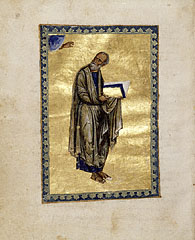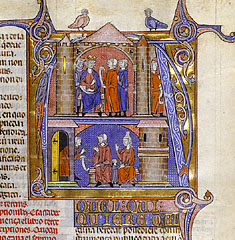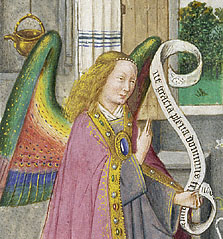The artistic aims of medieval painters often found their purest expression in manuscript illumination, one of the primary media of the Middle Ages and Renaissance. Illuminated manuscripts contain most of the finest surviving examples of medieval painting and therefore constitute the most complete record of its development. The art of illumination flourished in the early centuries of Christianity when the manuscript codex, or book, gradually replaced the papyrus roll of antiquity as the vehicle for the written word. Because of the close connection of medieval Catholicism with the handwritten book, the texts of many manuscripts were embellished to enrich public or private religious experience. By the end of the medieval era, as Europe became wealthier and more worldly, a great variety of texts, both religious and secular, came to be illuminated.
Insular Manuscripts (seventh to eighth century)
The origins of Western European illumination was the Christian British Isles. The Insular miniatures of seventh-century Ireland developed the late antique practice of enlarging the first letter or initial at the beginning of a text into an entire page—known as a carpet page—which was covered with abstract designs. The tradition of using elaborately decorated text pages in books of Gospels and other liturgical manuscripts flourished into the Ottonian and Romanesque periods.
 |
||
Byzantine Manuscripts (sixth to 15th century)
In the Byzantine Empire, another tradition of manuscript illumination emerged. The most influential characteristics of Byzantine manuscript painting were the abundant use of precious metals, especially gold; the choice of bright colors; and the use of empty space, often filled with gold leaf, as background. Byzantine illumination was frequently devoted to narrating biblical stories. Styles of depicting the human figure varied in Byzantine art over the centuries.
Carolingian Manuscripts (eighth to ninth century)
The Emperor Charlemagne (reigned 800–814), whose empire extended from northern Germany to Italy, encouraged artists to emulate the naturalism of the ancient Greeks and Romans. Using Byzantine models that reflected classical art, Carolingian illuminators combined this naturalism with an exhilarating, nervous brushwork.
Ottonian Manuscripts (10th to 11th century)
In the mid-10th century, a line of German kings including Otto I, Otto II, and Otto III began to commission manuscripts that, as in the Carolingian tradition, were to be a visual manifestation of imperial power. The Ottonians also borrowed heavily from Byzantine art, using a narrative style that expresses the gravity and simplicity of Byzantine icons. The volumes of the figures and the spatial relationships are reduced to luminously colored patterns. The figures have large, expressive eyes and long, gesturing hands—motifs that are also derived from Byzantine art.
Romanesque Manuscripts (11th to 12th century)
Romanesque art was international in character, borrowing from both Insular and Byzantine art. The Insular focus on initials became the central element in Romanesque illumination, and the historiated initial, which contains an illustrative scene, was derived from the Byzantine interest in narrative. Patterned backgrounds along with abstract drapery were extremely popular.
 |
||
Gothic Manuscripts (13th to 15th century)
By the end of the 12th century, Parisian artisans had developed a new style of illumination characterized by sinuous figures, vivid narratives, and the lavish use of gold leaf. During the 13th century the English and German schools developed Gothic styles as well. French illuminators occasionally adopted the visual conventions of other art forms, such as stained glass windows, in order to narrate stories and teach church doctrine visually.
International Style (first half of the 15th century)
The International Style reached its height in the early 15th century at the ducal courts of Europe. At this time Jean, duc de Berry, one of the great patrons of this period, commissioned the famous Très Riches Heures. His illuminators, the Limbourg brothers, were among the great exemplars of a new naturalism, elegance, and fascination with landscape that quickly spread throughout Europe. The courtly manner of this style circa 1400–1420, is reflected in its bright colors, soft modeling, and delicate contours.
 |
||
The Renaissance (15th to 16th century)
The Renaissance in both Northern and Southern Europe was the last great era of the handwritten and illuminated book. Expanding literacy provided a stimulus for affluent middle-class patrons both to commission manuscripts and to purchase those made for the open market in towns and cities all over the continent. An illuminated private devotional prayer book, for example, became a symbol of its owner's status and taste. Renaissance illuminators also produced many secular works. The study of antiquity in Italy gave rise to beautifully illuminated humanistic texts.
Although Gutenberg's invention of the printing press in 1452 was not immediately successful, soon he and other printers throughout Europe were vying with scribes to meet the increased demand for books. Imitating the manuscript tradition, early printed books were often illuminated, and occasionally achieved the decorative splendor of luxury books. Eventually, however, the use of woodcuts and metal engravings replaced illuminated decoration in printed books. Within the next hundred years, the advent of the illustrated printed book led to the demise of a glorious tradition that had flourished in Europe for 10 centuries.